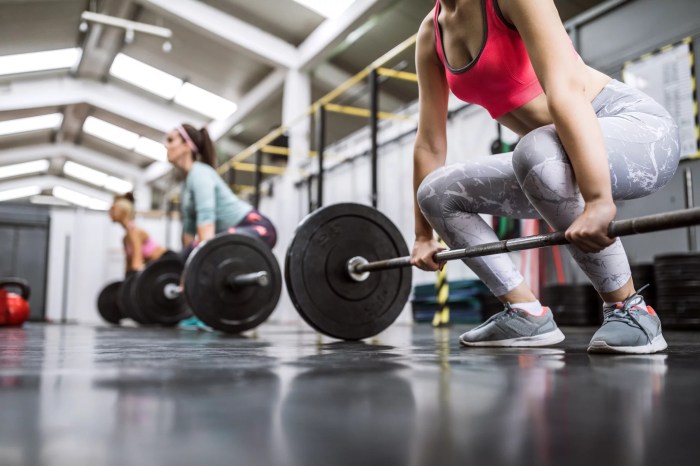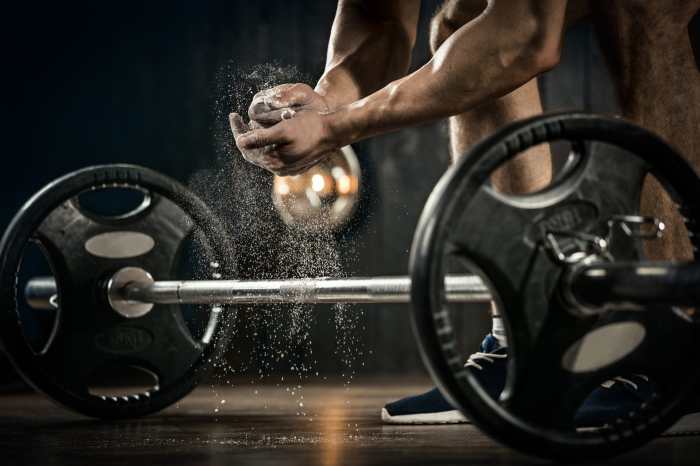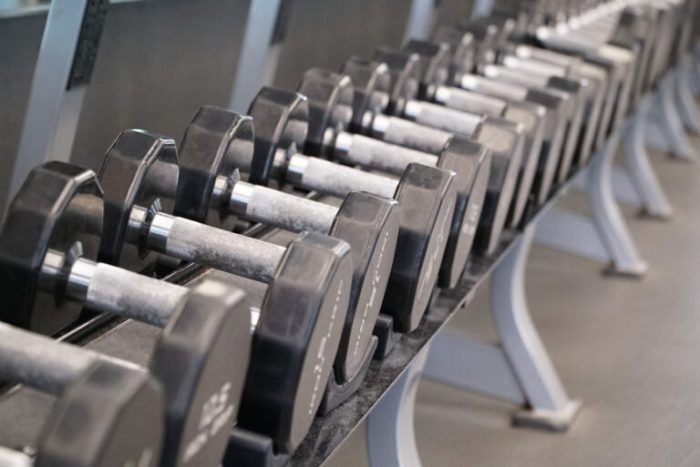Weights in gym – Weights in the gym are essential tools for building strength, improving fitness, and achieving a variety of health goals. From dumbbells to barbells and kettlebells, there’s a wide range of weights available to cater to different fitness levels and goals.
This guide will provide a comprehensive overview of weights in the gym, including their types, benefits, proper lifting techniques, and safety precautions.
Whether you’re a beginner or an experienced lifter, understanding how to use weights effectively can help you maximize your workouts and achieve your fitness aspirations. So, let’s dive into the world of weights in the gym and unlock the power of strength training.
Overview of Gym Weights: Weights In Gym
Gym weights are essential tools for strength training and overall fitness. They are designed to add resistance to exercises, allowing you to build muscle, increase strength, and improve overall athletic performance.
There are different types of gym weights, each with its own unique benefits. Dumbbells are versatile and can be used for a wide range of exercises. Barbells are ideal for compound exercises that work multiple muscle groups simultaneously. Kettlebells are a dynamic tool that can be used for both strength training and cardiovascular exercise.
Benefits of Gym Weights
Incorporating gym weights into your fitness routine offers numerous benefits, including:
- Increased muscle mass
- Enhanced strength
- Improved bone density
- Reduced risk of injury
- Boosted metabolism
- Improved cardiovascular health
Selecting Appropriate Gym Weights

Selecting the appropriate gym weights is crucial for optimizing your workouts and achieving your fitness goals. The right weight should challenge you without compromising your form or safety. Here are some guidelines to help you choose the right weight for different exercises.
Progressive Overload
Progressive overload is a fundamental principle of weightlifting that involves gradually increasing the weight or resistance over time. By consistently challenging your muscles with heavier weights, you force them to adapt and grow stronger. This process is essential for continuous progress and muscle development.
Consulting a Fitness Professional
If you are unsure about the appropriate weight to use for a particular exercise, it is highly recommended to consult with a certified fitness professional. They can assess your fitness level, form, and goals to provide personalized recommendations that align with your specific needs and abilities.
Proper Lifting Technique

Maintaining proper form when lifting weights is crucial for maximizing results and minimizing the risk of injury. Follow these principles to ensure you’re lifting safely and effectively.
The key principles of proper lifting technique include:
- Body position:Keep your back straight, chest up, and shoulders back.
- Foot placement:Stand with your feet shoulder-width apart, toes slightly pointed outward.
- Grip:Use a grip that is comfortable and secure, with your hands shoulder-width apart.
- Range of motion:Lift the weight through a full range of motion, but avoid overextending your joints.
Common Mistakes to Avoid
Here are some common mistakes to avoid when lifting weights:
- Lifting with a rounded back:This can put strain on your lower back and increase your risk of injury.
- Not engaging the core:Your core muscles help stabilize your spine and protect your back. Make sure to engage your core by keeping your abs tight and your back straight.
- Using too much momentum:Using momentum to lift weights can put unnecessary stress on your joints and increase your risk of injury. Lift the weight slowly and controlled, using your muscles to power the movement.
Common Weightlifting Exercises
Weightlifting is a great way to build muscle, burn fat, and improve your overall fitness. There are many different weightlifting exercises that you can do, and the best ones for you will depend on your fitness goals and experience level.
To get the most out of your weightlifting workouts, it’s important to learn how to perform each exercise correctly. This will help you avoid injuries and get the most out of your workouts.
Exercises by Muscle Group
Chest
- Barbell bench press: Works the chest, shoulders, and triceps. Lie on a bench with your feet flat on the floor and a barbell held over your chest. Lower the barbell to your chest and then press it back up to the starting position.
- Dumbbell flyes: Works the chest. Lie on a bench with a dumbbell in each hand. Raise the dumbbells to the sides and then lower them to the sides, keeping your elbows slightly bent.
- Incline dumbbell press: Works the upper chest. Sit on an incline bench with a dumbbell in each hand. Press the dumbbells up to the starting position.
Back
- Barbell row: Works the back, shoulders, and biceps. Stand with your feet shoulder-width apart and a barbell held in front of your thighs. Bend over at the waist and row the barbell up to your chest.
- Pull-ups: Works the back, shoulders, and biceps. Hang from a pull-up bar and pull yourself up until your chin is above the bar.
- Lat pulldowns: Works the back and biceps. Sit at a lat pulldown machine and pull the bar down to your chest.
Legs
- Barbell squat: Works the legs, glutes, and core. Stand with your feet shoulder-width apart and a barbell held across your upper back. Squat down until your thighs are parallel to the floor and then stand back up.
- Leg press: Works the legs and glutes. Sit in a leg press machine and press the platform away from you.
- Hamstring curls: Works the hamstrings. Lie on a bench with your feet on a pad. Bend your knees and curl the pad up to your glutes.
Shoulders
- Overhead press: Works the shoulders, triceps, and upper back. Stand with your feet shoulder-width apart and a barbell held over your head. Lower the barbell to your shoulders and then press it back up to the starting position.
- Lateral raises: Works the shoulders. Stand with your feet shoulder-width apart and a dumbbell in each hand. Raise the dumbbells to the sides until they are parallel to the floor.
- Front raises: Works the shoulders. Stand with your feet shoulder-width apart and a dumbbell in each hand. Raise the dumbbells in front of you until they are parallel to the floor.
Biceps
- Barbell curl: Works the biceps. Stand with your feet shoulder-width apart and a barbell held in front of your thighs. Curl the barbell up to your shoulders and then lower it back down.
- Dumbbell curls: Works the biceps. Stand with your feet shoulder-width apart and a dumbbell in each hand. Curl the dumbbells up to your shoulders and then lower them back down.
- Hammer curls: Works the biceps. Stand with your feet shoulder-width apart and a dumbbell in each hand. Curl the dumbbells up to your shoulders, keeping your elbows tucked in.
Triceps
- Triceps pushdowns: Works the triceps. Sit at a triceps pushdown machine and push the bar down until your elbows are fully extended.
- Overhead triceps extensions: Works the triceps. Stand with your feet shoulder-width apart and a dumbbell in each hand. Raise the dumbbells overhead and then lower them behind your head.
- Skullcrushers: Works the triceps. Lie on a bench with a barbell held over your head. Lower the barbell to your forehead and then press it back up to the starting position.
5. Safety Precautions

Weightlifting is a great way to improve your fitness, but it’s important to be aware of the potential risks involved. By following these safety guidelines, you can help to prevent injuries and make sure your workouts are safe and effective.
The most common weightlifting injuries include muscle strains, joint pain, and cardiovascular problems. To prevent these injuries, it’s important to use proper form, lift within your limits, and have a spotter when necessary.
Warming Up and Cooling Down
Warming up before your workout helps to prepare your body for the activity ahead. This can help to prevent injuries and improve your performance. Some good warm-up exercises include light cardio, such as jogging or cycling, and dynamic stretching, such as arm circles and leg swings.
Cooling down after your workout helps to reduce muscle soreness and stiffness. Some good cool-down exercises include static stretching, such as holding each stretch for 30 seconds, and light cardio, such as walking or swimming.
Common Weightlifting Injuries
| Injury | Symptoms | Prevention |
|---|---|---|
| Muscle strain | Pain, swelling, and bruising | Use proper form, lift within your limits, and warm up before your workout. |
| Joint pain | Pain, swelling, and stiffness | Use proper form, lift within your limits, and warm up before your workout. |
| Cardiovascular problems | Chest pain, shortness of breath, and dizziness | Get a medical checkup before starting a weightlifting program, and listen to your body and stop if you experience any pain. |
“Safety is the most important thing in weightlifting. By following these guidelines, you can help to prevent injuries and make sure your workouts are safe and effective.”
– American Council on Exercise
Recovery and Rest
Recovery and rest are crucial aspects of weightlifting. They allow your muscles to repair and grow, and help prevent injuries. There are two main types of recovery: active recovery and passive recovery.
Active recovery involves engaging in light activities that promote blood flow and circulation, such as walking, swimming, or yoga. This helps to remove waste products from your muscles and speed up the recovery process.
Passive Recovery
Passive recovery involves complete rest. This allows your muscles to fully relax and repair. It is important to get enough passive recovery, especially after intense workouts.
Determining the Optimal Amount of Rest
The optimal amount of rest between workouts depends on a number of factors, including your fitness level, the intensity of your workouts, and your goals. A general rule of thumb is to rest for at least 24 hours before working the same muscle group again.
The Role of Nutrition in Recovery
Nutrition plays a vital role in recovery. Eating a healthy diet that is rich in protein, carbohydrates, and healthy fats will help your muscles repair and grow. It is also important to stay hydrated by drinking plenty of water.
Weightlifting for Specific Populations

Weightlifting offers numerous benefits, but it’s essential to consider specific considerations for different populations to ensure safety and effectiveness.
Beginners
Beginners should start gradually, focusing on proper form and technique. Choose lighter weights, start with fewer repetitions, and increase intensity gradually as you progress.
Older Adults
Older adults should prioritize exercises that maintain balance, mobility, and strength. Start with low weights and focus on compound exercises that work multiple muscle groups simultaneously.
Individuals with Injuries
Weightlifting can be beneficial for individuals with injuries, but it’s crucial to consult with a healthcare professional and physical therapist to determine appropriate exercises and modifications.
Weightlifting Community
Joining a weightlifting community offers numerous benefits, including:
Support and Accountability
Weightlifting buddies provide encouragement, motivation, and hold you accountable for your fitness goals.
Knowledge Sharing
Connect with experienced lifters who can share valuable insights, techniques, and tips.
Socialization
Weightlifting communities foster a sense of belonging and camaraderie among like-minded individuals.
Finding and Connecting with Weightlifters, Weights in gym
To find and connect with weightlifters, consider:
Joining a Local Gym
Gyms often have dedicated weightlifting areas and group classes where you can meet other lifters.
Attending Weightlifting Events
Local competitions, seminars, and workshops offer opportunities to connect with fellow enthusiasts.
Online Forums and Social Media
Join online weightlifting communities or follow fitness influencers to engage with other lifters.
Final Thoughts
Incorporating weights into your fitness routine can be a transformative experience. By understanding the different types of weights, proper lifting techniques, and safety precautions, you can harness the power of strength training to build a stronger, healthier, and more confident you.
Remember, consistency, dedication, and a commitment to safety are key to unlocking the full benefits of weights in the gym.
FAQ Resource
What are the benefits of using weights in the gym?
Weight training offers numerous benefits, including increased strength, improved body composition, enhanced bone density, reduced risk of chronic diseases, and improved mood.
How do I choose the right weight for my workouts?
Start with a weight that challenges you while maintaining good form. Gradually increase the weight as you get stronger, following the principle of progressive overload.
What are some common mistakes to avoid when lifting weights?
Lifting with improper form, using too much momentum, not engaging your core, and lifting too heavy for your fitness level are common mistakes to watch out for.
Leave a Reply